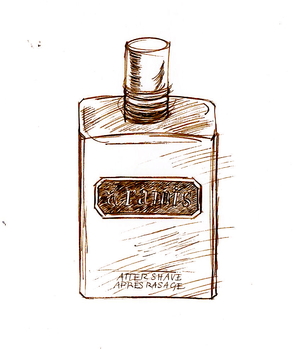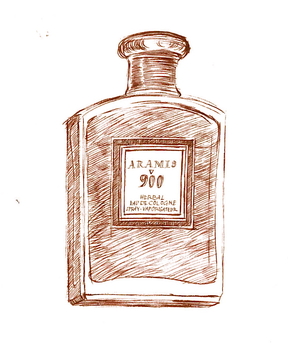Tagged With ‘Bernard Chant’
Aramis
Aramis
13 September, 2014
 Snobbery seeps into most areas of life, including perfume, and it’s never a very attractive trait, though it’s something that most of us have been afflicted by at one time or another – at least until we learn better.
Snobbery seeps into most areas of life, including perfume, and it’s never a very attractive trait, though it’s something that most of us have been afflicted by at one time or another – at least until we learn better.
As our knowledge of perfume grows, a lot of us get a bit embarrassed about the mass-market fragrances we might once have liked. In some cases that’s fair enough: I don’t imagine that, if I went back and smelled the M&S aftershave I was given for a teenage birthday, I would think ‘wow, what a fantastic example of the perfumer’s art’. On the other hand, by turning our backs on popular perfumes we risk throwing out the Brut with the bathwater.
Aramis illustrates this danger very well. It might have been around as long as anyone can remember. It might (at least until fairly recently) have been as cheap as chips. It might not have come in the most stylish bottle, or the most alluring packaging. Yet it’s actually a wonderful, sexy, high-quality fragrance, which deserves its place on any perfume-lover’s (cool, dark) shelf.
Aramis was launched in 1964, the same year as the original Brut for Men. The first perfume in Estée Lauder’s all-male range of fragrances and skincare, it came to Britain in 1965, and at first was sold exclusively in Harrods – which just shows you images can change.
It was created by one of the finest perfumers of the time, Bernard Chant, who worked for the perfume multinational, International Flavors and Fragrances (IFF), and died in 1987. Chant made his name with the women’s perfume, Cabochard, which was launched in 1959. Combining the dry, leathery smell of isobutyl quinolene with bitter orange, jasmine, ylang-ylang, and various kinds of spice, it was a powerful, confident scent, and quickly became a best-seller – though it has been repeatedly reformulated since, so today’s Cabochard bears little or no resemblance to the original.
I mention Cabochard at some length because, when Chant came to create Aramis for Men, it seems he simply (as far as anything is simple in perfumery) adapted the formula for Cabochard, taking some of the floweriness out and emphasising its leathery-woodiness. The result is an equally punchy fragrance with lots of depth, but just enough rough-edged masculinity (including the sharp spicy-sweaty smell of cumin) to make it appealing to the stubbliest of men.
Aramis is spicy, sweet and long-lasting, and though its spiciness initially made me think of Chanel’s Egoïste, a quick comparison reveals that the latter is much more floral, with a strong dose of vanilla that Aramis lacks. If it doesn’t smell as unusual as some of the men’s perfumes I love, that’s as much as anything to do that it has been around for so long that we’ve since smelled lots of cheap copies, making it seem less original than it actually was in its time.
Bernard Chant went on to create a number of other fine perfumes for Estée Lauder’s various brands, including Azurée (1969) and the well-known Aromatics Elixir (1971), as well as the men’s fragrances Aramis 900 (1973, reviewed here), Devin (1978) and JHL (1981), which were repackaged and relaunched in 2009. They’re all worth exploring, and there’s nothing about them to be snobbish about.
Aramis
Aramis 900
9 June, 2014

Aramis is one of those mid-market brands that seems to have been around for ever, and for that reason it’s often overlooked or, worse, looked down upon. Which is, I think, a shame, because there are some classic men’s perfumes in the range.
The all-men’s brand was launched in 1964 by Estée Lauder and her husband Joseph, with the eponymous Aramis (which I’ve reviewed here) as the first fragrance in the range. Though I’d always assumed the brand and the perfume were named after the character in The Three Musketeers, legend has it that it actually commemorates an obscure town in Armenia, which these days is transliterated as Yeremes. It sounds like a leg-pull, but then we’re also told that the Lauders were working with an Armenian designer at the time by the name of Arame Yeranyan, so you never know; I’ll let you know if I can get a definitive answer out of somebody.
Whatever the truth of the matter (and the perfume industry’s relationship with historical fact can sometimes be rather shaky), Aramis was a big success, and in 1973 it begat Aramis 900. Like the original Aramis it was created by Bernard Chant, a brilliant French perfumer who loved spicy, leathery fragrances, and it’s very much along those lines.
In fact, as it’s often been pointed out, if Aramis 900 hadn’t been marketed for men, it would have worked just as well as a woman’s scent – a good example of the obvious but too rarely grasped fact that in itself perfume has no gender. Just smell Clinique’s classic woman’s perfume, Aromatics Elixir, and you’ll see what I mean: it was also created by Bernard Chant and to many people smells identical to Aramis 900.
Aramis 900 is a deep, spicy, complicated scent, which makes most contemporary offerings smell weedy and washed-out by comparison. Today you’d only expect to find a men’s fragrance smelling this rich and complex in an expensive ‘exclusive’ range like Tom Ford or Armani Privée, but when it was launched it was aimed squarely at the middle market: these were not expensive perfumes.
Like the majority of other men’s perfumes, Aramis 900 includes lemon and bergamot, but among its more persistent and powerful ingredients are carnation, orris (iris) root, geranium, oakmoss, patchouli and vetiver, as well as rosewood oil, the natural form of which comes from an increasingly threatened rainforest tree, Dalbergia nigra.
Unlike most modern men’s perfumes, though, Aramis 900 has a predominantly floral scent, which to me smells like a mix of clove-scented carnation and old-fashioned rose. Though floral fragrances were popular with Victorian men, in 20th-century western culture they came to be thought of as ‘girly’, though for no particularly logical reason as far as I can see.
Luckily that didn’t stop perfumers from using floral ingredients in men’s perfumes, but in the case of Aramis 900 those flowery scents are brilliantly disguised by all sorts of other things, including a faintly ‘dirty’ smell that adds an oddly sexy extra to the mix. The forest-floor oakmoss and vetiver also stop it smelling sweet, while the carnation (despite being a flower) gives it the same kind of peppery spiciness that you can smell in Chanel’s Egoïste.
The amazing thing, to me, is that perfumes like Aramis 900 have been so cheap for so long, but in 2009 it seems to have dawned on Estée Lauder Inc what they had on their hands, and six perfumes in the Aramis range – including Aramis 900 – were relaunched and repackaged in matching bottles. Now priced at a less mass-market £60 and titled a ‘Gentleman’s Collection’, presumably the hope is that men who liked one fragrance might go on to collect the rest. Given the quality of most men’s fragrances today I’d say that wouldn’t be a bad idea.